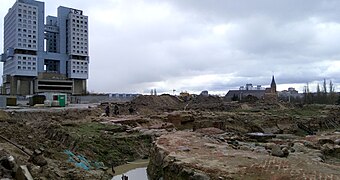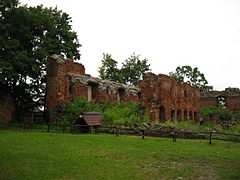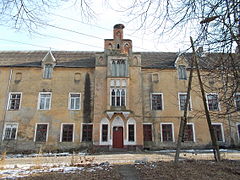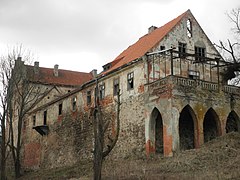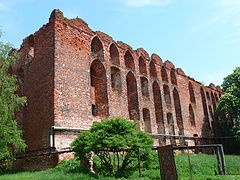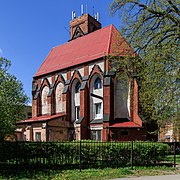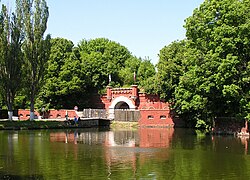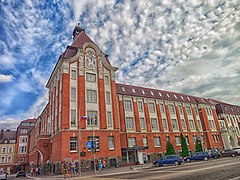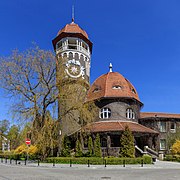Cultural heritage of Kaliningrad Oblast

The cultural heritage of Kaliningrad Oblast is a mixture of the pre-World War II German, Lithuanian and Polish heritage, dating back to the Ducal Prussian and East Prussian periods, and the Soviet and Russian designs constructed since then.
History
[edit]Many heritage sites in Kaliningrad Oblast were damaged during World War II, or willfully destroyed in the postwar period by Soviet authorities.[1] A number of landmarks did survive, such as the gothic Königsberg Cathedral containing the tomb of Kant, or the Königsberg Stock Exchange building.[2] Already in the 1960s, a group of local architects and intellectuals began to campaign for the preservation of the region's German heritage, albeit unsuccessfully.[3]
The first Soviet housing blocks were built only in 1966.[4] The spread of Soviet-style prefabricated panel buildings eventually changed the appearance of Kaliningrad. The 1970s House of Soviets is another part of the local Soviet architectural period.[2]
Mirroring the rediscovery of pre-revolutionary history in the rest of Russia, since 1991 there have been many efforts to recover the prewar heritage sites of Kaliningrad.[1] Preservation and reconstruction efforts are hampered by a complicated property ownership situation, as during the 1990s the city administration raised cash by selling land for construction without regard for central planning.[5]
Old buildings are being restored, and new ones built in conscious imitation of the old Königsberg architecture.[3] Some local architects are cautious about the reconstruction efforts, worried that the result may end up looking too kitsch and unauthentic.[5]
Königsberg Cathedral was successfully restored from 1992 to 1998, in a joint Russian-German project.[3] The Fischerdorf development, while being a new development, is a city quarter that intentionally mirrors the prewar architectural styles.[3] A project to restore Kant's House in Veselovka was announced in 2013, and should be completed in time for the 2018 World Cup.[6]
The ruins of Königsberg Castle are being excavated, with a plan to preserve them under a transparent enclosure.[7]
Lithuanian heritage
[edit]
This section needs expansion. You can help by adding to it. (May 2024) |
The eastern part of the current Kaliningrad Oblast was part of the region of Lithuania Minor, traditionally inhabited by Lithuanian people, and preserved Lithuanian heritage is thus mostly located there. In Chistye Prudy (Lithuanian: Tolminkiemis), there is a Memorial Museum of Kristijonas Donelaitis, author of The Seasons, the first Lithuanian poem. Several churches, which hosted Lithuanian services for the region's Lithuanian population in the past, are located in the province, including the preserved churches in Slavsk (Gastos) and Saranskoe (Laukiška) and ruins in Chernyshevskoye (Eitkūnai), Kalinino (Mielkiemis), Ozyorsk (Darkiemis) and Ulyanovo (Kraupiškas). The Lithuanian Church in Sovetsk (Tilžė), traditional capital of Lithuania Minor,[8] was destroyed by the Soviets in 1951–1952.
Polish heritage
[edit]This section needs expansion. You can help by adding to it. (May 2024) |

Polish people historically inhabited especially Königsberg (Polish: Królewiec), the current southern border strip, plus some locations in the central (e.g. Chernyakhovsk/Wystruć, Znamensk/Welawa and Zagorskoye) and northern parts of the current oblast.
The former Polish Church at Steindamm (Polish: Kamienna Grobla), the main Polish Church of Königsberg (Królewiec) and the city's oldest church, where Jan Seklucjan, publisher of the oldest Polish translation of the New Testament, was a pastor in the mid-16th century,[9] was demolished by the Soviet administration in 1950. In 1972, the Soviets destroyed the main church of Chernyakhovsk (Wystruć), which also hosted Polish services in the past. The Königsberg Cathedral was historically also a place of worship for local Poles with Polish-language services held there until the 18th century. It contains the epitaph of 17th-century Polish princely magnate Bogusław Radziwiłł and his wife Anna Maria, renovated in 2007–2008 with funds from the Polish Ministry of Culture and National Heritage.[10]
A number of villages in the current southern border strip were founded by Poles several centuries ago, e.g. Kazachye (Piątki), Nekrasovo (Karpowo Wielkie), Maltsevo (Karpówko) near Krylovo (Nordenbork),[11] and Chorzele and Chorzelki near Mamonovo (Święta Siekierka).[12] In 1945, the southern border strip even initially passed under Polish control with Polish administration organized in the towns of Gierdawy and Iławka, however, the Polish administration was eventually expelled and the area was annexed by the Soviet Union and included within the Kaliningrad Oblast.[13]
In 2011, a Polish-built monument with Polish and Russian inscriptions was unveiled at the site of the former Hohenbruch concentration camp at Gromovo where Nazi Germany imprisoned mostly Poles, especially intelligentsia.[14]
Gallery
[edit]Castles
[edit]-
Excavation of the Königsberg Castle ruins in 2018
-
Schaaken Castle ruins
-
Balga castle ruins
-
Insterburg Castle ruins
-
Brandenburg Castle ruins
-
Ragnit Castle ruins
-
Preußisch Eylau Castle
-
Labiau Castle
City gates
[edit]-
Friedland Gate in Kaliningrad
Religious buildings
[edit]-
Former St. Adalbert's Church
-
Saint George church, Pravdinsk
-
Saint Bruno Church, Chernyakhovsk
Forts
[edit]-
Pillau Fortress
-
Fort V "Friedrich Wilhelm III"
-
Fort №1 Stein am Lauther Muhlenteich
Other pre-war sights
[edit]-
Baltiysk Lighthouse
-
Ozerki Lock, Masurian Canal
-
Administration building in Gusev
-
Palace in Saranskoe
Postwar heritage
[edit]-
Monument to the 1200 Guardsmen
See also
[edit]References
[edit]- ^ a b Myers, Steven Lee (13 August 2002). "Kaliningrad Journal; A Russian City Digs Up Its Past and Finds Germany". The New York Times. Retrieved 11 May 2018.
- ^ a b "Remaking history: how Kaliningrad's new centre will look both forward and back". The Calvert Journal. 27 January 2015. Retrieved 11 May 2018.
- ^ a b c d Savinova, Maria (Spring 2015). "KALININGRAD VS. KÖNIGSBERG: The role of the renaming discussion for the formation of the Kaliningrad regional identity" (PDF). University of Tampere. Retrieved 11 May 2018.
- ^ "Russia: Is Kaliningrad Looking For A New Identity?". Radio Free Europe / Radio Liberty. 10 September 2002. Retrieved 11 May 2018.
- ^ a b Beyer, Susanne (25 July 2014). "Resurrecting Königsberg: Russian City Looks to German Roots". Spiegel Online. Retrieved 11 May 2018.
- ^ "Kant's House near Kaliningrad to welcome first visitors in 2018". welcome2018.com. Retrieved 11 May 2018.
- ^ "Ruins of Koenigsberg Castle to open for 2018 World Cup tourists". welcome2018.com. Retrieved 11 May 2018.
- ^ Słownik geograficzny Królestwa Polskiego i innych krajów słowiańskich, Tom XII (in Polish). Warszawa. 1892. p. 702.
{{cite book}}: CS1 maint: location missing publisher (link) - ^ Arnoldts, Daniel Heinrich (1777). Kurzgefaßte Nachrichten von allen seit der Reformation an den lutherischen Kirchen in Ostpreußen gestandnen Predigern. Königsberg. p. 42.
- ^ "Epitafium Bogusława Radziwiłła i jego żony w Kaliningradzie" (in Polish). Retrieved 22 May 2024.
- ^ Maroszek, Józef (2007). Przewodnik historyczno-turystyczny po dziedzictwie kulturowym pogranicza Polska – Litwa – Kaliningrad (in Polish). Białystok. p. 388.
{{cite book}}: CS1 maint: location missing publisher (link) - ^ Słownik geograficzny Królestwa Polskiego i innych krajów słowiańskich, Tom XI (in Polish). Warszawa. 1890. p. 692.
{{cite book}}: CS1 maint: location missing publisher (link) - ^ Eberhardt, Piotr (2018). "Kwestia podziału Prus Wschodnich w okresie II wojny światowej". Przegląd Geograficzny (in Polish). 90 (4): 610. ISSN 0033-2143.
- ^ "Tam zginął Seweryn Pieniężny". Olsztyn24 (in Polish). 25 March 2011. Retrieved 22 May 2024.
External links
[edit]- List of cultural landmarks of Kaliningrad Oblast on WikiVoyage (in Russian)
 Media related to Cultural heritage monuments in Kaliningrad Oblast at Wikimedia Commons
Media related to Cultural heritage monuments in Kaliningrad Oblast at Wikimedia Commons

